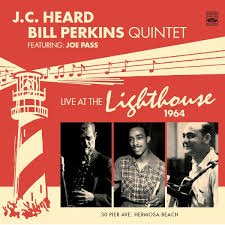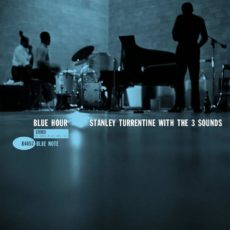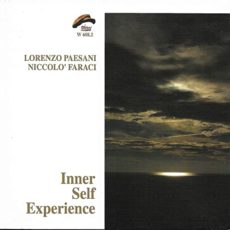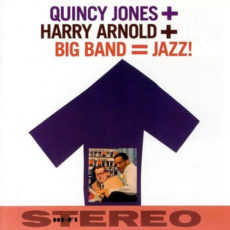
Daily Dose Of Jazz…
James Charles Heard, known as J. C. Heard was born on August 10, 1917 in Dayton, Ohio and grew up in Detroit, Michigan. As a young child, he performed as a tap dancer in amateur contests and vaudeville shows. He began to switch his focus to drumming around age 11 and started out teaching himself to play, then took lessons as a student at Cass Technical High School. Supporting his interest, his parents brought him to see major performers who toured to Detroit’s famous music venues, however, it was Chick Webb play in 1937 as a formative experience.
Becoming a protege of the drummer Jo Jones, through him he met and sat in with Count Basie. With Jones’s help, Heard got his first professional job with Teddy Wilson’s band in 1939. They played the Golden Gate Ballroom in Harlem and the Roseland Ballroom and recorded for Columbia Records. After the Wilson band’s breakup, he went on to perform in bands led by Benny Carter, Louis Jordan, Louis Armstrong, Benny Goodman, Duke Ellington, Woody Herman, and Dizzy Gillespie. He also performed at major jazz festivals and played alongside Roy Eldridge and Charlier Parker.
Heard’s style was a hybrid of swing and bop and was known for his innovative techniques and the hard swing he would bring to both large and small bands. He recorded with Charles Mingus, Ray Brown, Billie Holiday, Ray Charles, Nat King Cole, Dinah Washington, Lena Horne, and Sarah Vaughan. He also led his own bands, including a quintet that played at Cafe Society and a trio with Erroll Garner and Oscar Pettiford. Performing as a featured member of Cab Calloway’s band from 1942-1945, he appeared in several Hollywood films, including Stormy Weather.
During the Fifties Heard toured with Norman Granz’s Jazz at the Philharmonic in the 1950s and after a successful engagement in Japan in 1953, stayed for many years performing and teaching. Returning to New York in 1957, J.C. played with the Coleman Hawkins-Roy Eldridge Quintet and with Teddy Wilson’s trio. In 1966 he moved back to Detroit where he was influential as a bandleader and a mentor to younger musicians. In 1983, he again recorded an album as a leader, accompanied by saxophonist George Benson, pianist Claude Black, and Dave Young on bass. In 1981, Heard started a 13 piece big band which played around the state and at festivals, often featuring Dizzy Gillespie and other colleagues. This group recorded in 1986 and continued performing regularly until his death.
Drummer J. C. Heard passed away from a heart attack on September 27, 1988 at the age of 71 in Royal Oak, Michigan. His legacy is honored with a yearly jazz drumming competition held as part of the Detroit Jazz Festival.
More Posts: bandleader,drums,history,instrumental,jazz,music

Requisites
Blue Hour ~ Stanley Turrentine With The Three Sounds | By Eddie Carter
In the hands of Stanley Turrentine, the tenor saxophone was an instrument of soulful creativity and immense power. From his 1960 debut, Look Out to his biggest hit, Sugar in 1971, Turrentine’s credentials were second to none as a giant of Hard-Bop, Modal, and Soul-Jazz. This morning’s choice from the library joins him with Gene Harris on piano; Andrew Simpkins on bass and Bill Dowdy on drums who were collectively known as The Three Sounds. Blue Hour (BLP 4057/BST 84057) was released in 1961 and is the second record where The Three Sounds backed a saxophonist, the other is 1959’s LD + 3 with Lou Donaldson. My copy used in this report is the 2015 Music Matters 33 1/3 Stereo audiophile reissue (MMBST-84057). I Want A Little Girl, written by Murray Mencher and Billy Moll in 1930 starts Side One. This infrequently heard ballad opens with an angelic introduction illustrating Harris’ attentiveness to the lyric and melody. Stanley brings a beautifully expressive sound and delicate sincerity to the opening chorus, then adds a graceful sensitivity to his solo. Gene’s interlude is brief but lovely and the closing by the quartet is captivating.
Gee Baby, Ain’t I Good To You was written in 1929 by Don Redman and Andy Razaf. Its first recording was by The King Cole Trio in 1943 and a year later, it became a hit for Nat King Cole and a jazz standard with numerous recordings to its credit. The Three Sounds provide a respectful treatment with a pensive introduction, allowing Turrentine to deliver the evocative theme with warm and affectionate feelings. The saxophonist also weaves a reverent spell of subtle lyricism on the opening solo. Harris is up next for the closer with a thoughtfully tender interpretation that speaks to the soul. The only original on the album ends the first side, Gene Harris’ Blue Riff takes the tempo to a medium beat during the first statement moving with a finger-popping, toe-tapping groove. The threesome states the melody, then Stanley takes over for a jubilant solo of vivacious spontaneity. Gene takes the next turn for a bouncy, bright presentation with a youthful spirit. Stanley returns for a few final compulsive choruses before the pianist takes the threesome into the fade-out.
Since I Fell For You by Buddy Johnson opens Side Two. He composed both the music and lyrics, introducing it in 1945 with his sister Ella on vocals. The Three Sounds start the song with a stylishly soft, slow-paced introduction as natural as if it was written for this quartet exclusively. This segues into a soothing opening melody by Turrentine who solos twice, putting his stamp on both interpretations displaying tranquil restraint on the first and closing statements. Harris contributes a tender reading that’s lovingly stated, anchored by Simpkins and Dowdy’s voluptuous foundation. Willow Weep For Me, written by Ann Ronell in 1932 begins with the exquisitely mellow tone of Stanley’s tenor sax having an intimate conversation with the rhythm section on the opening chorus. Gene’s first solo is elegant and laid-back, revealing its true beauty with gorgeous verses preceding an alluring climax. Stanley’s closing performance is soulful and bluesy like a leisurely walk on a warm summer evening with the trio proving the ideal companion to take the tune into a luscious coda.
Gene Harris, who was known for his gospel jazz style formed The Three Sounds in 1956 with Andy Simpkins and Bill Dowdy. The group became a hit with the public and when Blue Hour was recorded, the trio was amid a four-year run (1958-1962) recording a total of twelve albums for Blue Note including four in 1960 alone. The other three are Feelin’ Good, It Just Got To Be, and Moods. I believe that’s why Alfred Lion didn’t release the additional eight songs of this session on another album. The Three Sounds’ were together until 1970 when Harris left to embark on a successful solo career. Stanley Turrentine was a veteran of the Soul-Jazz style since the fifties and he recorded a total of seventeen LP’s for the label as a leader, plus several as a sideman with Donald Byrd, Kenny Burrell, Jimmy McGriff, Ike Quebec, Horace Parlan, Duke Pearson, Shirley Scott (who he was married to at the time), Jimmy Smith, and Art Taylor.
In his liner notes, noted author, jazz historian and journalist Ira Gitler offers one definition of the Blue Hour as that early morning time “when you reach across the pillow where your Baby used to lay” and find him (or her) not there. The sound quality is stunning, the remastering of Rudy Van Gelder’s original tapes by RTI Record Technology Incorporated is superb and the gatefold photos of each musician during the session compliments the music marvelously. This record is nearly thirty-nine minutes of enjoyable jazz by Stanley Turrentine and The Three Sounds that adds weight to any jazz library. It’s well worth auditioning for a spot in your library and an LP that’s perfect to enjoy any time of the day, evening, or early morning during the Blue Hour.
~ Feelin’ Good (Blue Note BLP 4072/BST 84072); Gee Baby, Ain’t I Good To You (Capitol 169); It Just Got To Be (Blue Note BLP 4120/BST 84120); LD + 3 (Blue Note BLP 4012/BST 84012); Look Out (Blue Note BLP 4039/BST 84039); Moods (Blue Note BLP 4044/BST 84044); Sugar (CTI Records CTI 6005) – Source: Discogs.com
~ I Want A Little Girl, Gee Baby, Ain’t I Good To You, Since I Fell For You, Willow Weep For Me – Source: Wikipedia.org
© 2020 by Edward Thomas CarterMore Posts: bass,choice,classic,collectible,collector,drums,history,instrumental,jazz,music,piano,saxophone

Daily Dose Of Jazz…
Lorenzo Paesani was born on August 9, 1977 in Teramo, Abruzzo, Italy and studied piano since childhood. He graduated Summa Cum Laude at 21 from the Niccolò Piccinni Conservatory of Bari. He studied improvisational music all over Europe and the U.S. with John Taylor, Fabrizio Puglisi, Franco D’Andrea, Ralph Alessi, Tim Berne, Marc Ducret, among others.
He collaborated with Norma Winston, Massimo Manzi, Claudio Fasoli, Sound Sketches Orchestra, Sidma Jazz Orchestra, and the Turin Philharmonic Orchestra among others.
Since 2014 he has performed at a variety of jazz festivals across Europe, recorded with different ensembles but all projects have a particular blend of jazz, original compositions and open improvisation, spanning from modern jazz to contemporary music. In his role as a composer, he collaborates with Kairostudio, a cultural association that produces documentaries and movies about the safeguard of the environment. Pianist and bandleader Lorenzo Paesani continues to perform, record and explore the realm of music
More Posts: bandleader,composer,history,instrumental,jazz,music,piano

Daily Dose Of Jazz…
Charlie H. “Devil” Gaines was born on August 8, 1900 in Philadelphia, Pennsylvania. As a teenager, Gaine played in brass bands in his hometown before moving to New York City in 1920. It was there that he joined the orchestra of Wilbur Sweatman.
Signing on with Clarence Williams’s house band, he went on to play with Sam Wooding, Earl Walton, Leroy Smith, Fats Waller, Charlie Johnson, and the Hot Chocolates.
In the 1930s Gaines launched his own band in Philadelphia, recorded occasionally, including once with Williams in 1934. Simultaneously he continued playing with Smith while playing in Louis Armstrong’s orchestra. He continued to lead bands in Philadelphia into the 1950s, especially at the jazz venue Carroll’s.
The 1960s saw him performing in a trio at the Hangover Club until he went into retirement in the 1970s. Trumpeter and bandleader Charlie Gaines passed away on November 23, 1986.
More Posts: bandleader,history,instrumental,jazz,music,trumpet

Daily Dose Of Jazz…
Harry Arnold Persson was born on August 7, 1920, in Helsingborg, Sweden and led his first big band in 1942, playing the saxophone initially but eventually ceased to perform, concentrating on arranging.
From 1949-52 he played and arranged for Thore Ehrling’s band and worked extensively as a studio musician, particularly writing film scores through much of the 1950s. From 1956 to 1965 Arnold led the Swedish Radio Big Band, which included Arne Domnérus, Bengt Hallberg, and Åke Persson.
American trumpeter Benny Bailey played with the band for a time, Quincy Jones arranged and briefly led the group, and they recorded with Ernestine Anderson, Lucky Thompson, Coleman Hawkins, Toots Thielemans, Tony Scott, and Stan Getz.
Disbanding the group in 1965, Arnold continued working as an arranger and led big bands in Europe. Saxophonist and bandleader Harry Arnold passed away on February 11, 1971 at the age of 51 in Stockholm, Sweden.
More Posts: arranger,bandleader,history,instrumental,jazz,music,saxophone



